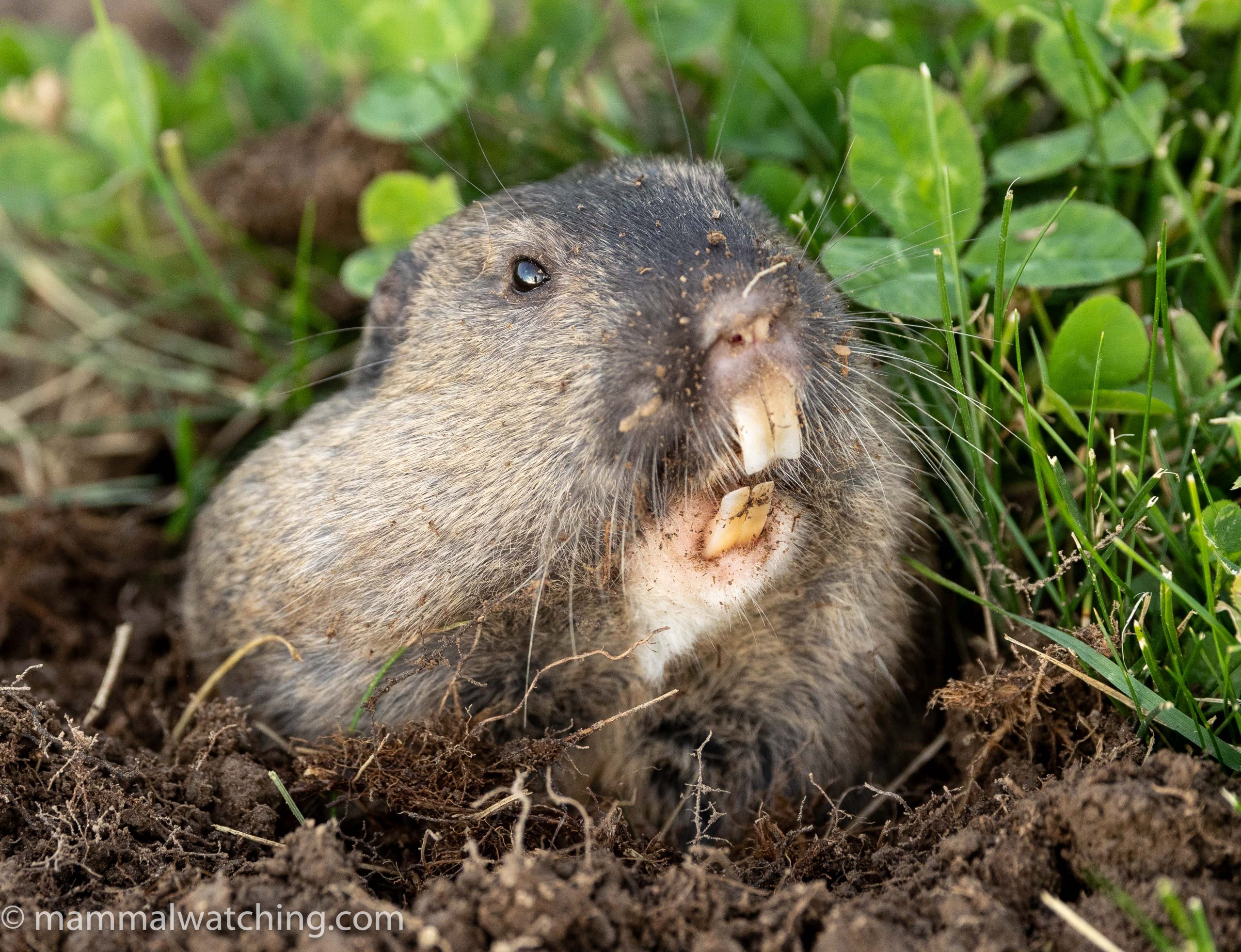
Rodent Recce, Northwest USA, August 2024
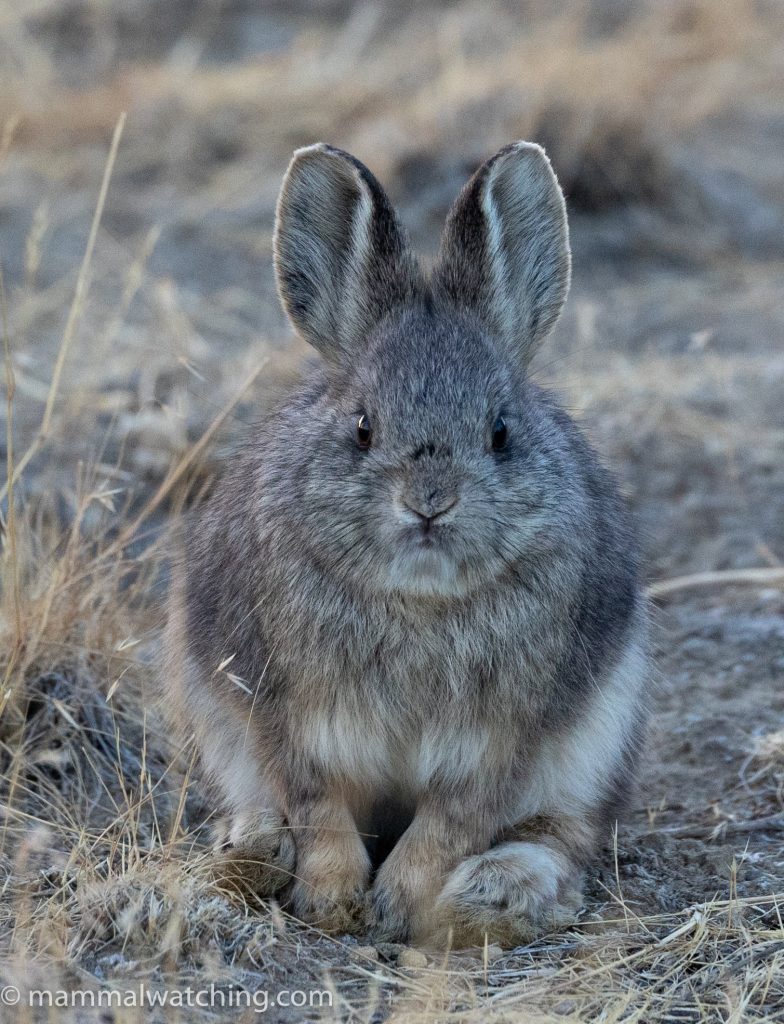
Pygmy Rabbit (Sylvilagus idahoensis). Captive breeding colony, Beezley Hills Preserve, Washington.
In August I took a whistle-stop tour around the northwest corner of the USA, from Boise, Idaho down to the Oregon/Nevada border and across to northern California via Oregon’s Crater Lake National Park. I headed up the coast and then drove northeast to finish in Spokane Washington.

2000 miles and 10 days later I had seen five of the rodents I was looking for, and missed another five or so species I was hoping for. Here’s a quick report of the more interesting sites I visited.
Boise, Idaho
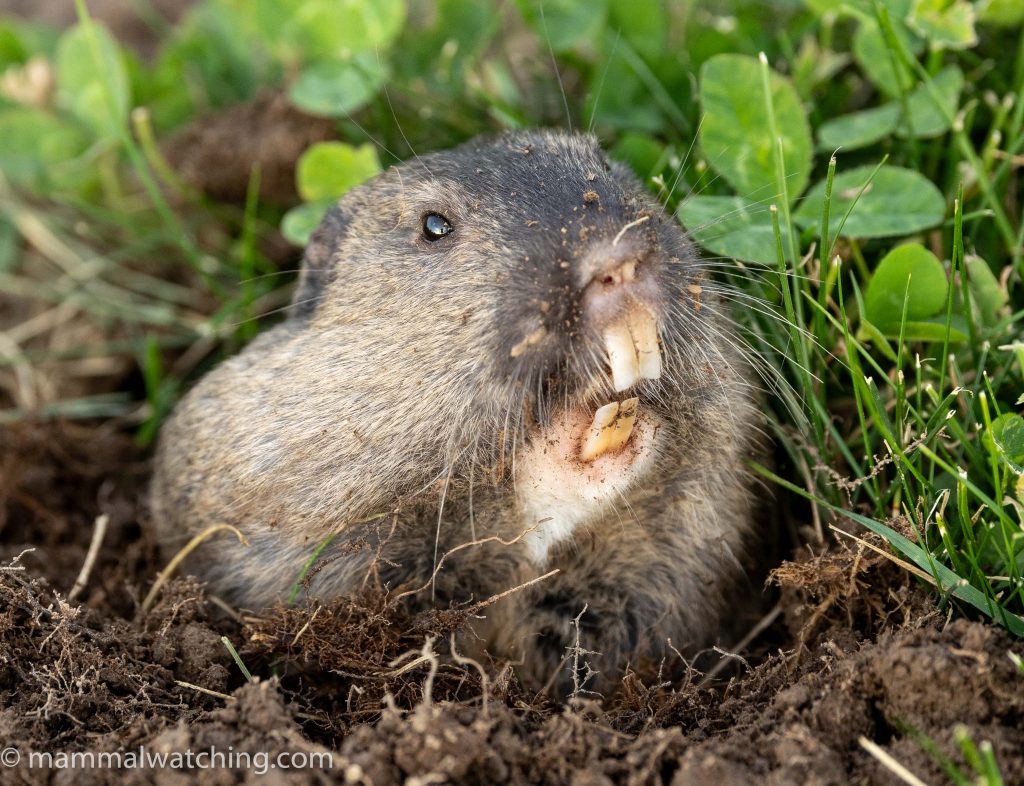
Townsend’s Pocket Gopher (Thomomys townsendii)
Matt Miller, Idaho’s most famous mammalwatcher, and his family generously hosted me for a weekend of mammal fun based around three target species.
It took Matt 10 minutes to show me one of the Townsend’s Pocket Gophers that live in Bowler Park a few minutes drive from his house. Last time I was with Matt he had found me a Northern Pocket Gopher, but this colony of Townsend’s was a newer discovery. Although it hadn’t rained in weeks in Boise, there were plenty of fresh mounds in the well-irrigated areas of the park. We pushed a small stick into a few of the freshest mounds to opening the entrance holes. Five minutes later one had been re-sealed. I reopened the tunnel and waited. The gopher appeared a minute later. A short video is here. I love gopherwatching. Lifer number one!
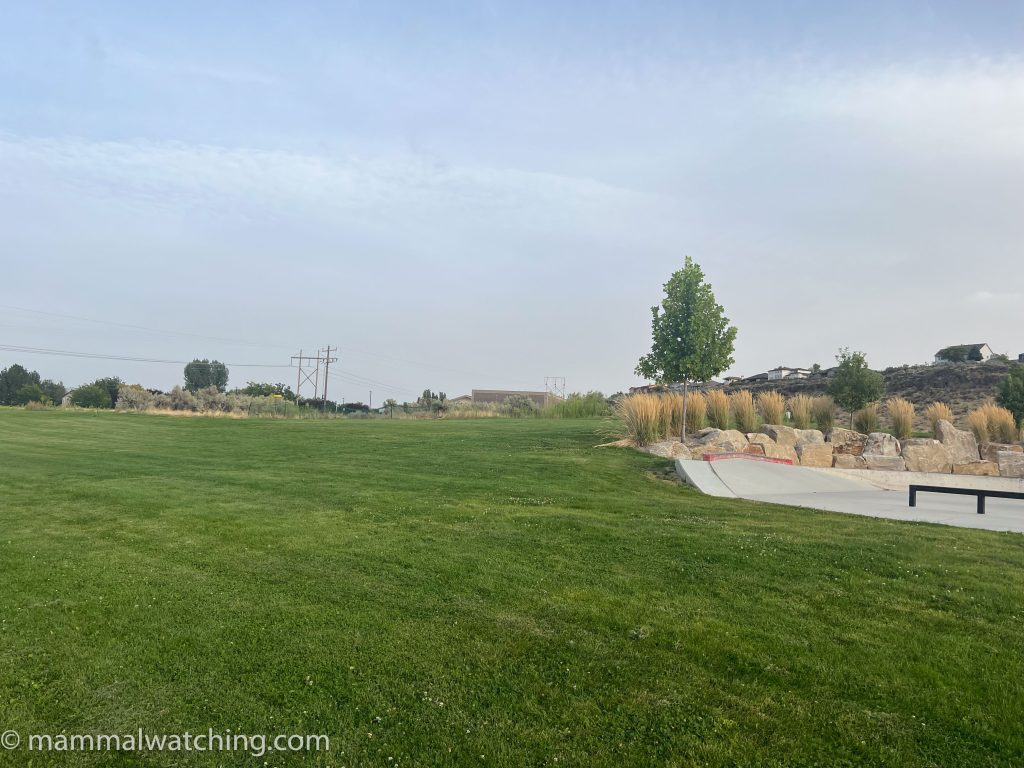
Townsend’s Pocket Gopher habitat
Matt had visited the previous evening too and had – without any need for a poking stick – seen animals active in and out of their burrows. So this is a good spot.
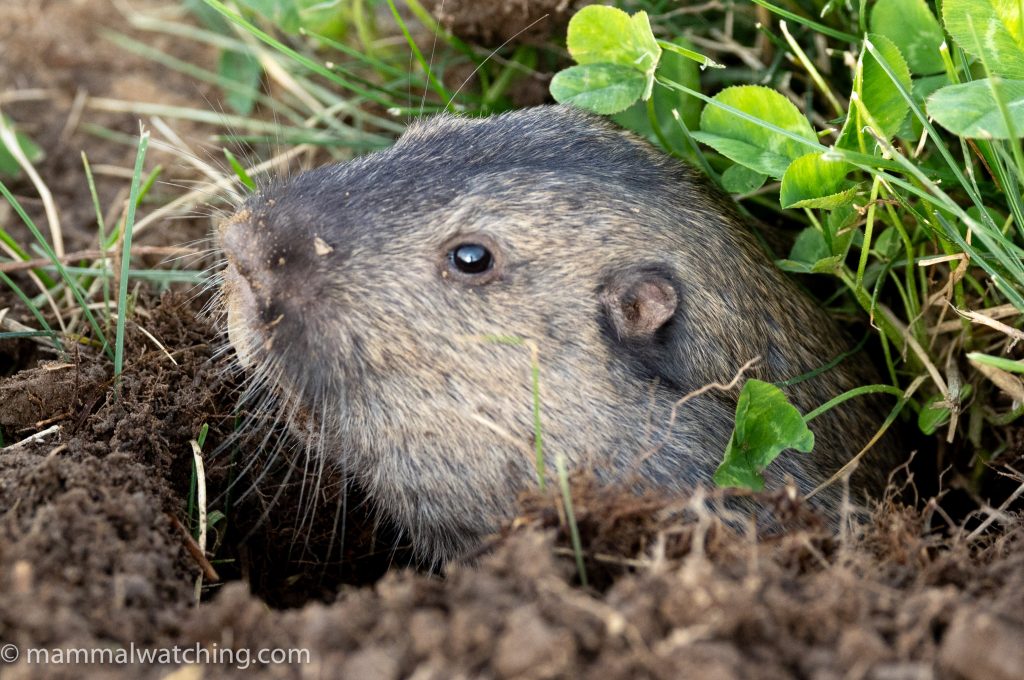
Townsend’s Pocket Gopher (Thomomys townsendii)
Craters of the Moon National Monument, Idaho
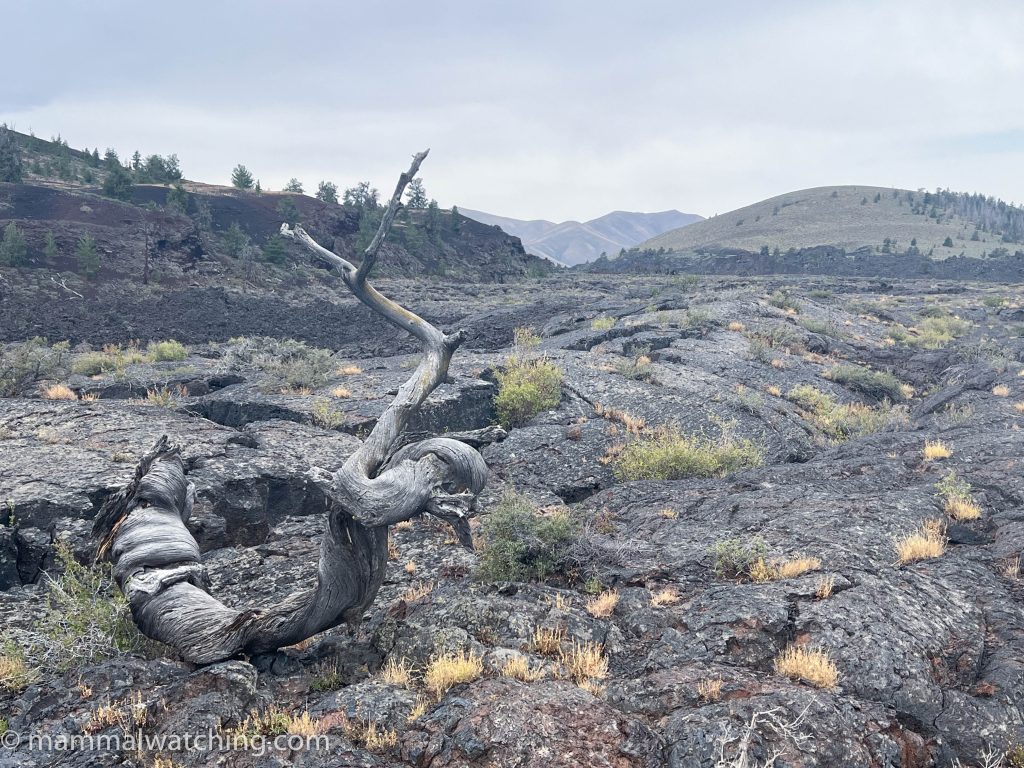
Craters of the Moon National Monument
The Millers and I took an overnight trip to Craters of the Moon National Monument. Our main goal was the newly described Crater Chipmunk. We saw our first at the entrance booth at midday, and another two or three around the campsite immediately afterwards. But once a cold wind began to blow the chipmunks disappeared and we didn’t see any over the next three hours. We were lucky to arrive when we did. Lifer number two.
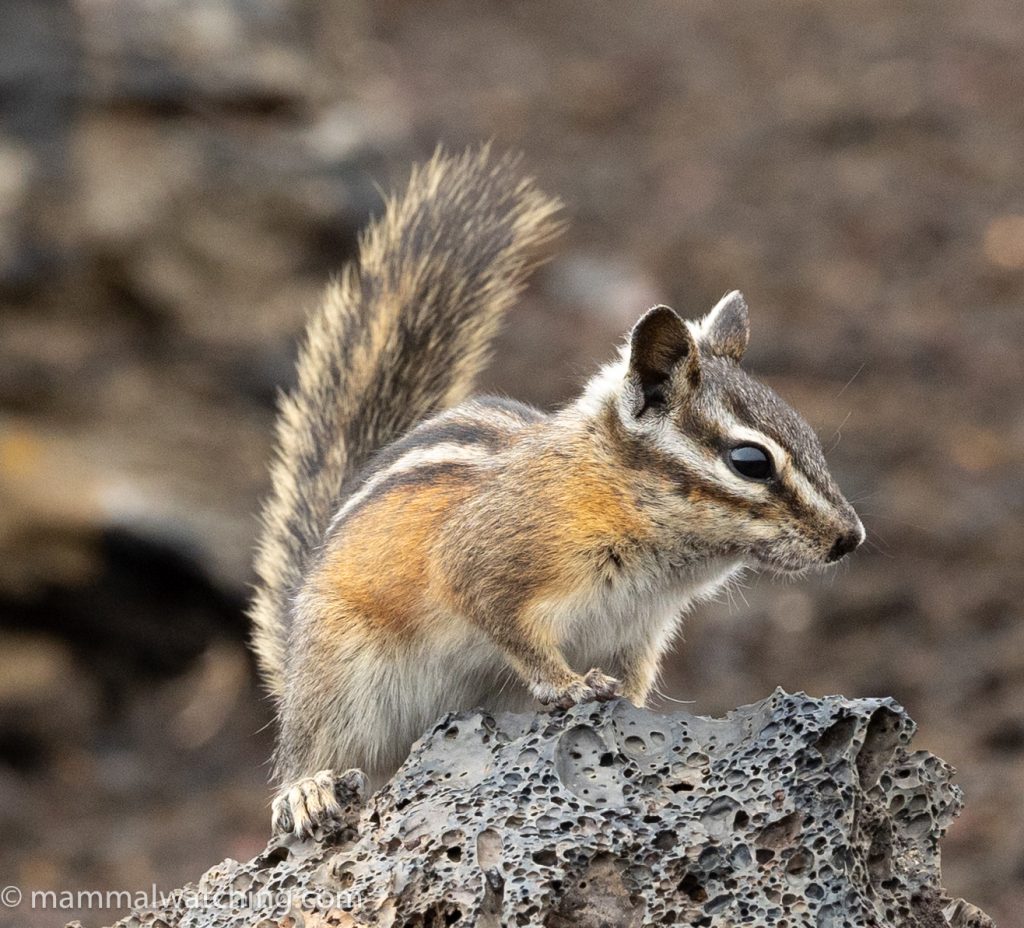
Crater Chipmunk (Neotamias cratericus)
Scientists who described the new species had given me advice beforehand: Crater Chipmunks are common around the campsite and the Devil’s Orchard areas of the national monument, and while Least Chipmunks are also in the area, they are much grayer and found only in the sagebrush.
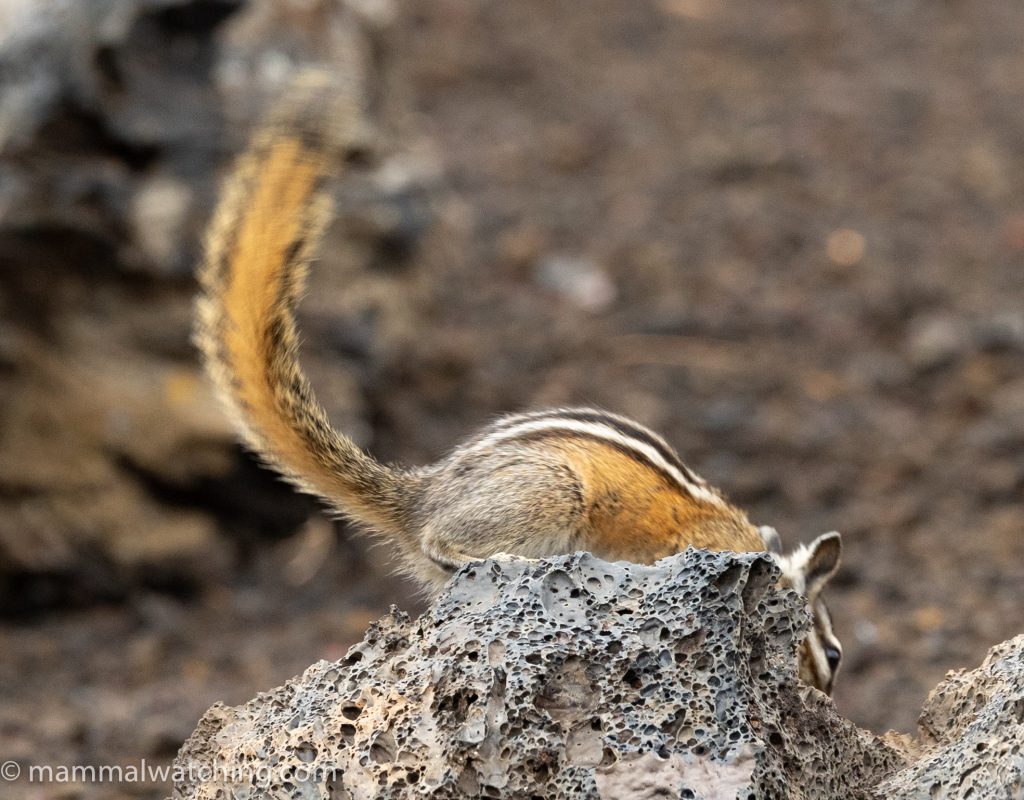
Crater Chipmunk (Neotamias cratericus)
We spent the night in nearby Bellevue, where I was hoping to see a Columbia Plateau Pocket Mouse (Perognathus parvus) around Rock Creek Ranch. Matt and I spent a couple of hours at dusk thermaling for rodents. The sagebrush was alive with Montane Voles before dark. We must have seen 30 or more.
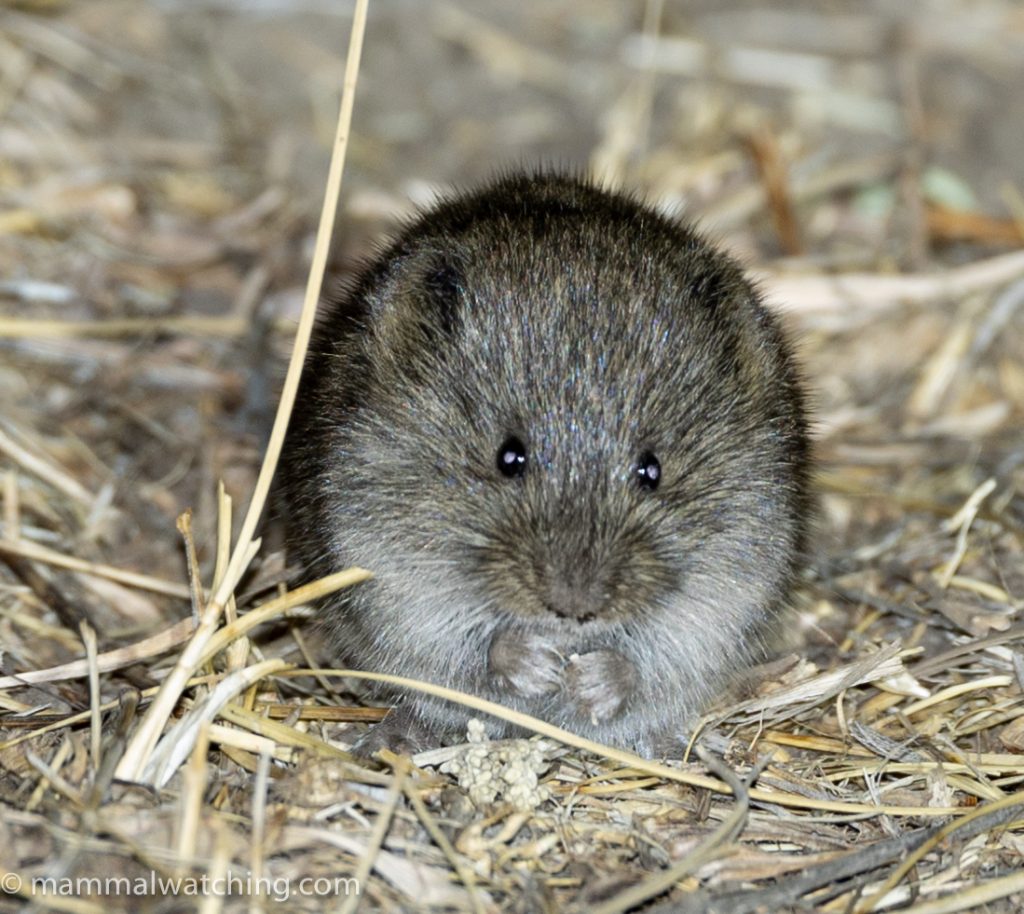
Montane Vole (Microtus montanus)
Once it was truly dark the voles disappeared and we saw no mammals. Perhaps because temperatures that day had dropped by 10C. The night was so cool I needed a jacket. If I was a pocket mouse I too would have struggled to get out of bed.
Sheldon National Antelope Refuge, Nevada/Oregon border
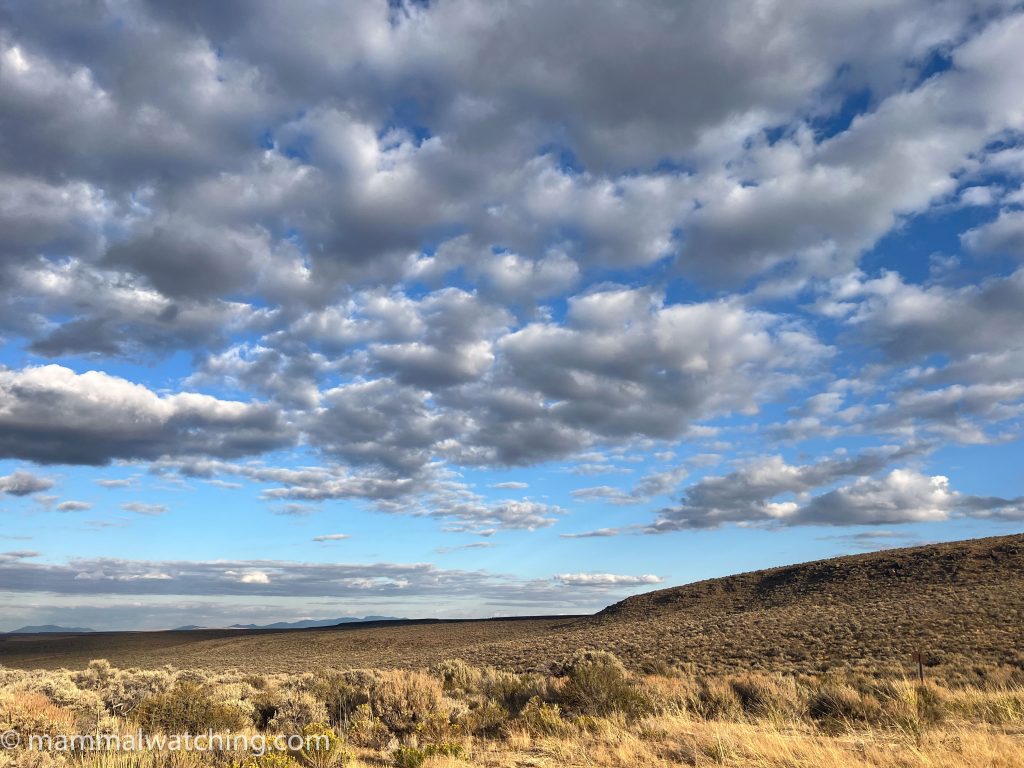
Pygmy Rabbit habitat
I had only seen a Pygmy Rabbit once – at Fossil Butter National Monument – and I wanted a better look. Miranda Crowell (a Pygmy Rabbit researcher who I would meet later on the trip) had recommended the Sheldon National Antelope Refuge as one of the best places anywhere to see Pygmy Rabbits, in any of the patches of big sagebrush, including along Hwy 140 that runs through the park.
It is an isolated and beautiful reserve. I camped at the Gooch Spring primitive camping area which I had to myself. There was plenty of rodent activity. Montane Voles, Ord’s Kangaroo Rats, Western Deermice and this pocket mouse which I thought was the Columbia Plateau Pocket Mouse I had been chasing the night before. Unfortunately my happiness was short-lived: the species here is the Great Basin Pocket Mouse. Not a lifer but good to see nonetheless.
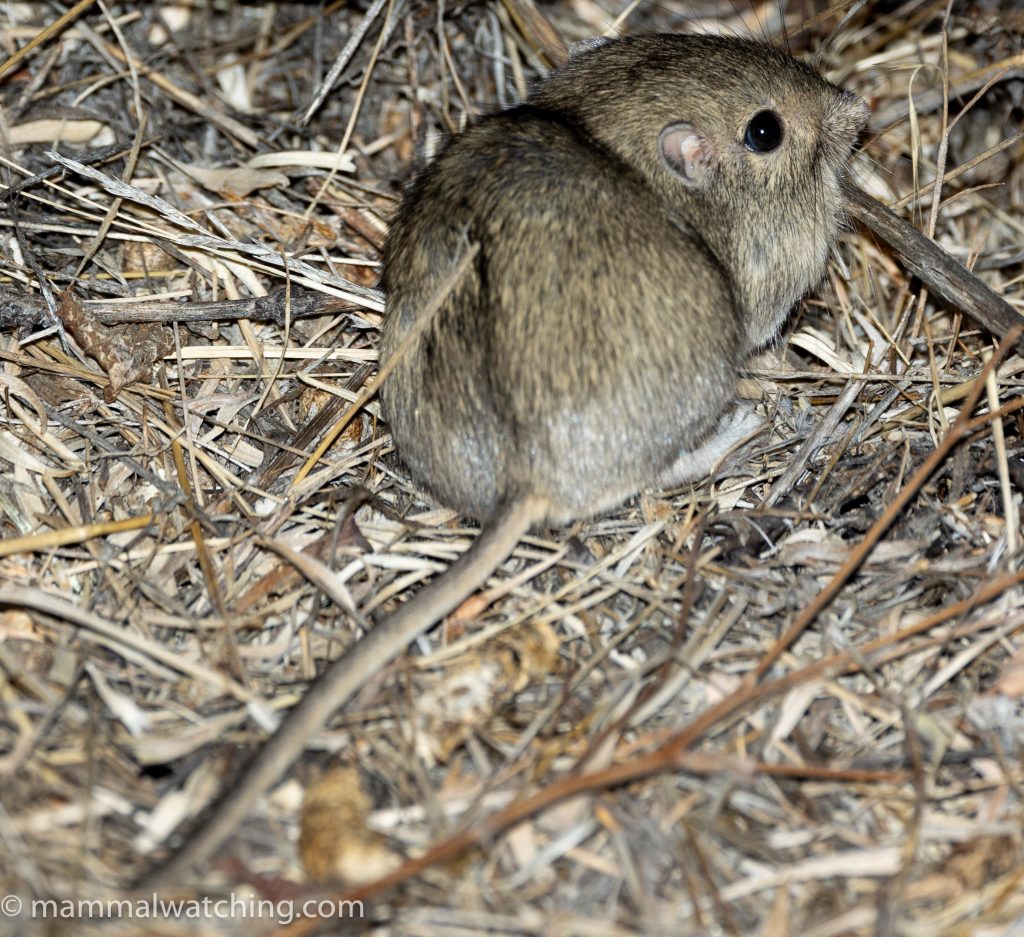
Great Basin Pocket Mouse (Perognathus mollipilosus)
There were a few Mountain Cottontails in the grassy clearing around the campsite after dark. I saw several other small rabbits that night and in the first hour or two of daylight that might have been Pygmy Rabbits. I didn’t see any white tails … but in every case I saw them only for a second or two running for cover so cannot say for certain.
A stunning place and I would love to go back. With a bit more time it ought to deliver Pygmy Rabbit sightings.
Crater Lake, Oregon
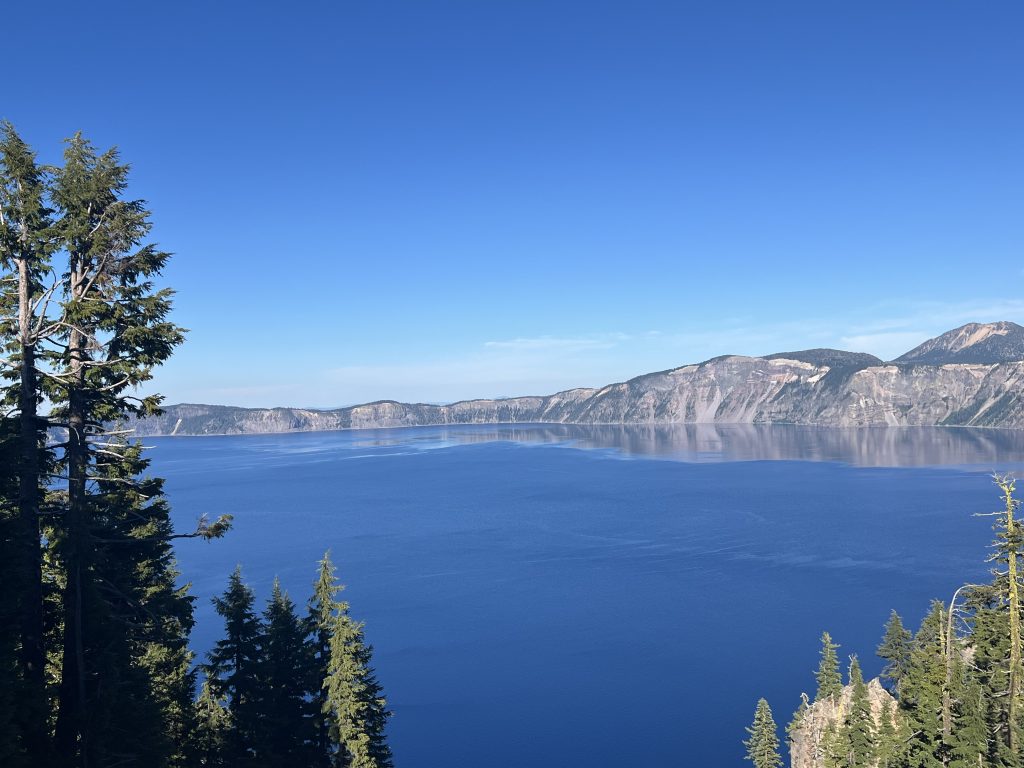
I spent a night here to look for Pacific Martens and Western Pocket Gophers.
I did not see a marten although they are around. A ranger told me she had seen one hunting pika a few weeks earlier. A server in the cafe by the campsite had seen one peering through the cafe window. I’d read that the campground could be a good spot for them but the camp host claimed she never saw them. Yet a ranger told me told someone had seen one in the campsite the day I arrived. Who knows? They are around but it wasn’t clear where I should focus my efforts.
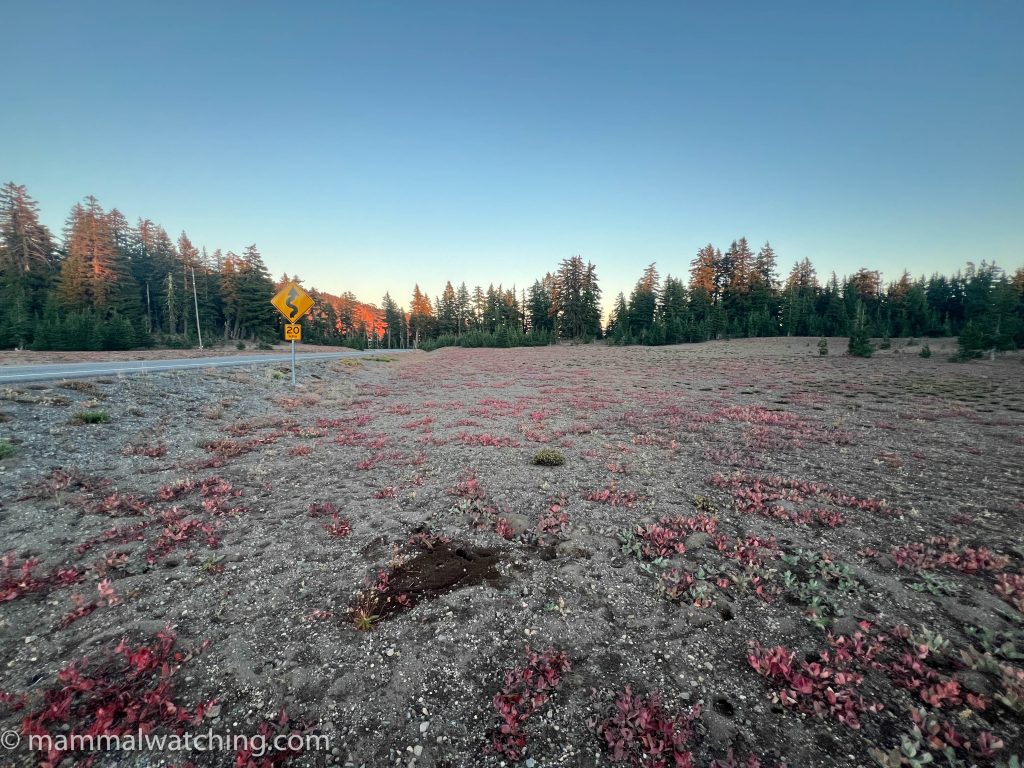
Western Pocket Gopher diggings
On the other hand, Western Pocket Gophers (Thomomys mazama) – the only pocket gopher species in the park – are abundant (thank you Lex Orr – pelagicvole from iNaturalist for the tip). There were mounds all over the park and they were particularly visible in meadows along the road from the visitor centre to the lake rim. I briefly saw a pocket gopher active at dusk though only managed this crappy cellphone video. My third lifer of the trip.
Prairie Creek Redwoods State Park, California
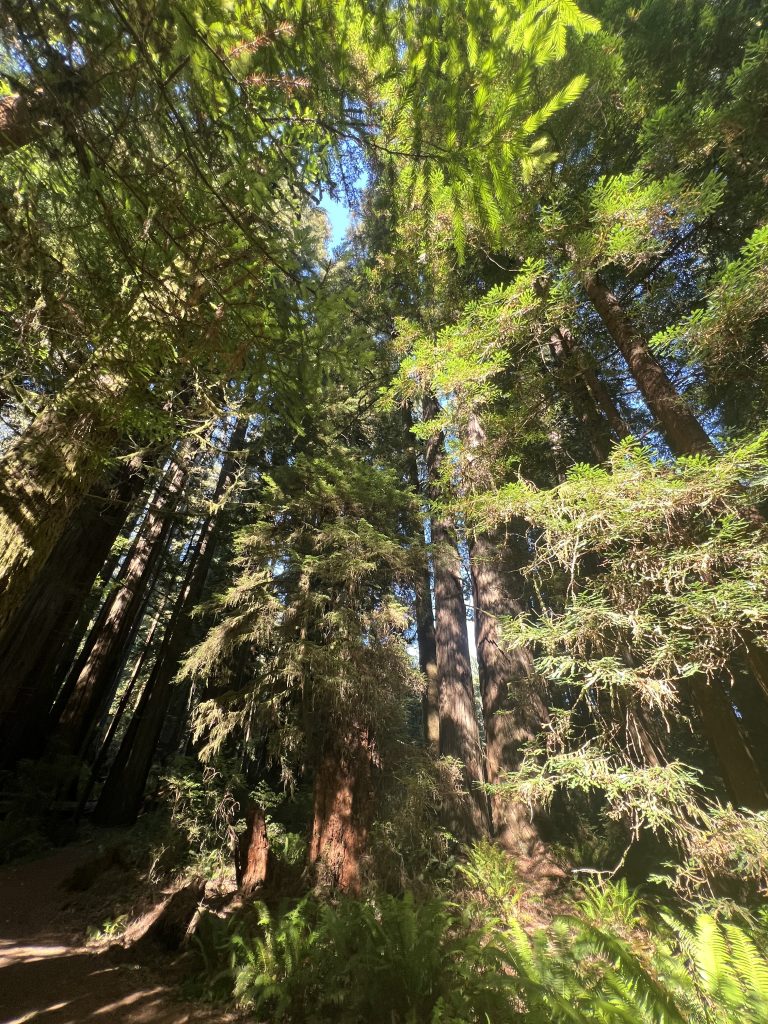
Venkat Sankar sang the praises of this park after he visited in June, He had seen a Western Red-backed Vole, Pacific Jumping Mice and a Creeping Vole around the Elk Prairie Campground and surrounds. It is indeed a fabulous campsite and looked like it ought to be nirvana for small mammals. But a few hours thermaling in the evening – in the campsite and along nearby Lost Man Creek trail – produced only two Western Deer Mice. Perhaps cooler, damper June is better for small mammal activity.
The impressive Roosevelt Elk, however, were impossible to miss.
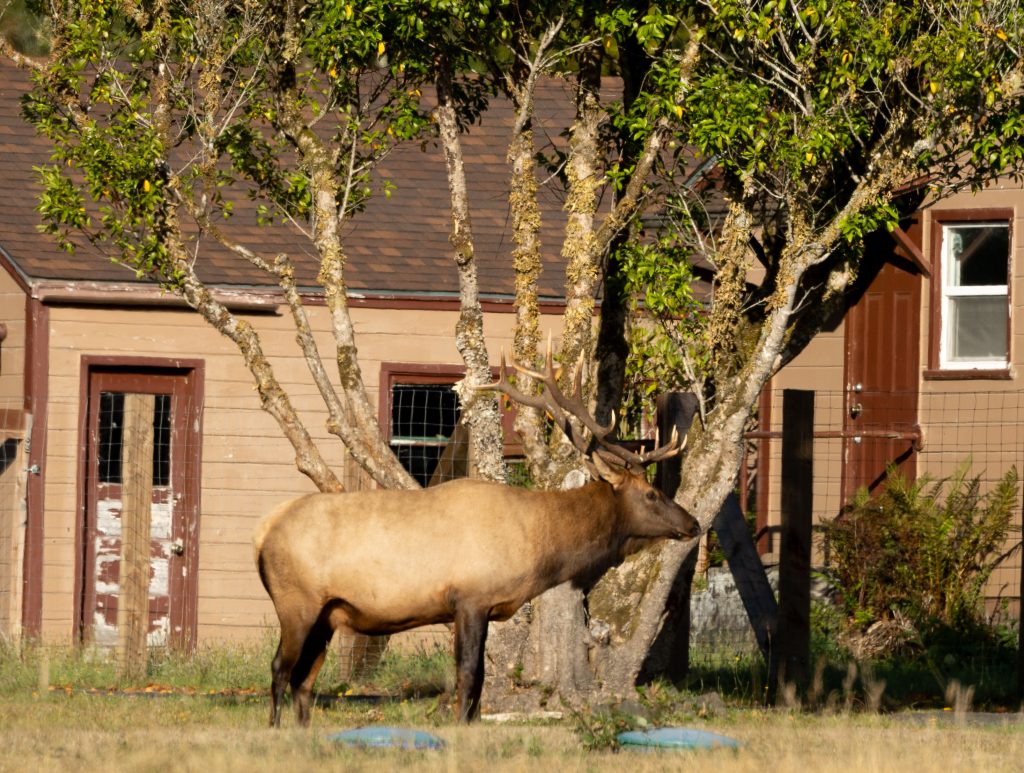
Rooselvelt Elk (Cervus canadensis roosevelti)
Mount Humbug, Port Orford, Oregon
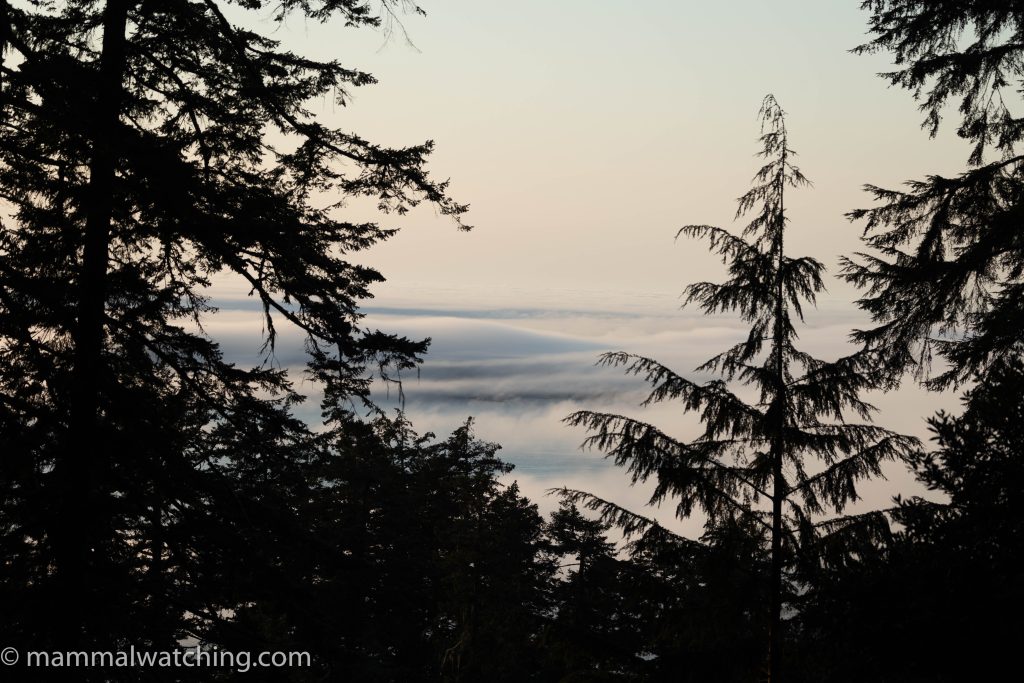
Red Tree Voles were a top target for the trip: these tiny voles nest high in conifers and seem to spend the vast majority of their time in the trees. The are hard to see but I thought my new Zeiss thermal scope (review coming soon) might be up to the task. Lex Orr (Pelagicvole on iNaturalist) had several arborimus records and recommended I look for them on Humbug Mountain near Port Orford, where she had seen several nests a few months earlier. It was a beautiful hike up the trail in the early evening.On Lex’s advice I focussed my attention along the first half mile of the trail that runs west from where the trail splits (this point is itself a mile from the trail head). I spent an hour before dark looking for nests, and then two hours very slowly thermaling walking back down to my car.
I did not see a vole. I could not even spot a nest, despite lots of advice from Lex. I think I need to return with someone who knows what to look for. I did see a Western Deer Mouse and this bat perched high in a Douglas Fir, most likely a Long-eared Myotis.
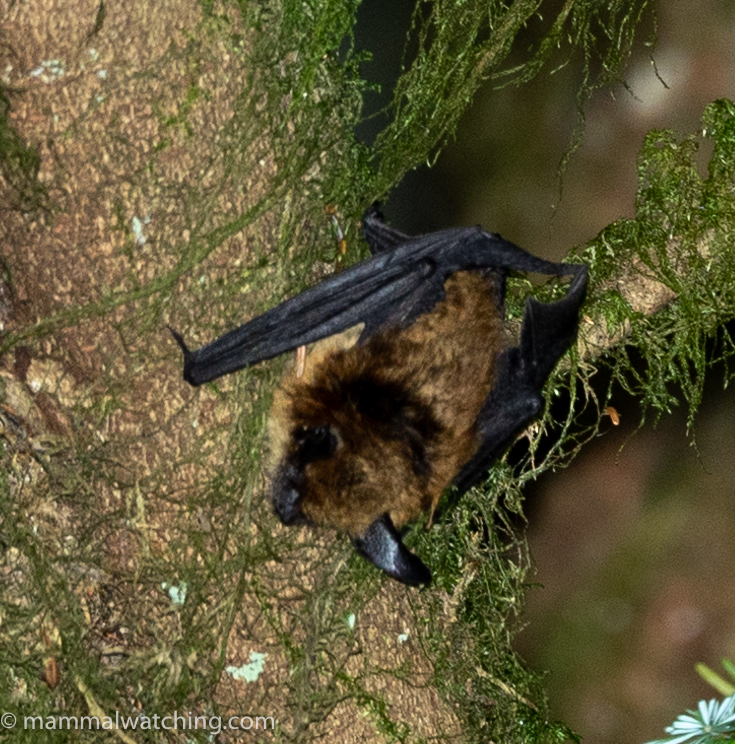
Probable Long-eared Myotis (Myotis evotis)
Someone had seen a Mountain Lion on the trail a few days earlier and there were warnings about the danger of using the trail after dark. I didn’t pay much attention until I found a lump of very fresh puma poo on the trail. It helped me concentrate on the way back down. Every 10 minutes or so I would spin around… just in case…
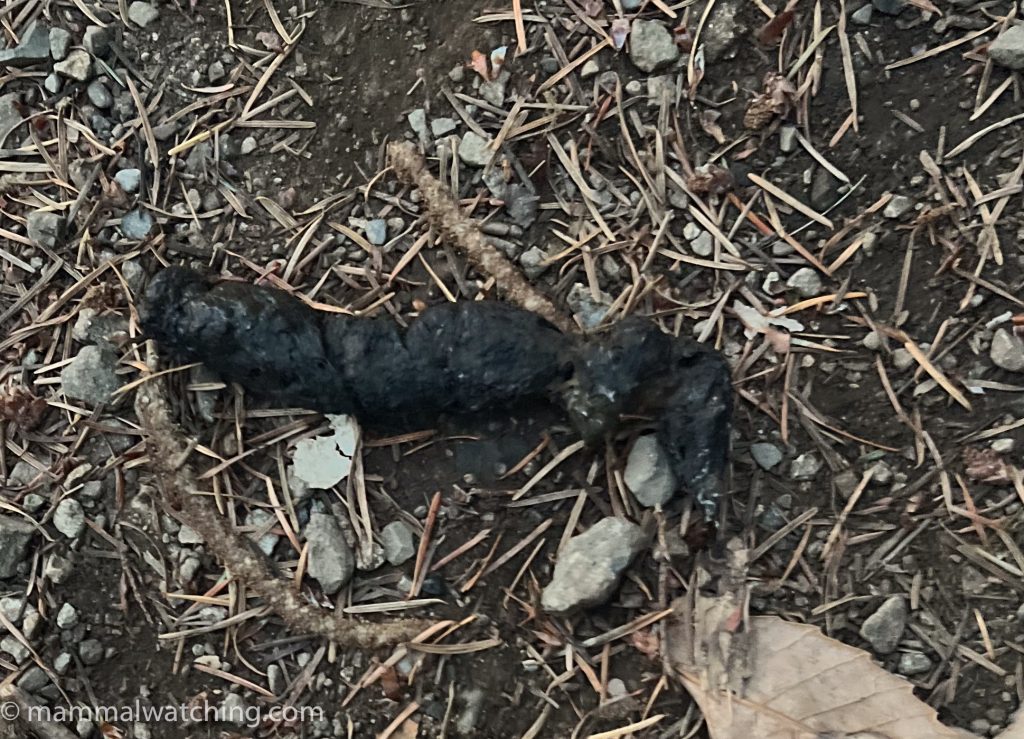
Mountain Lion scat
Heceta Head, Oregon
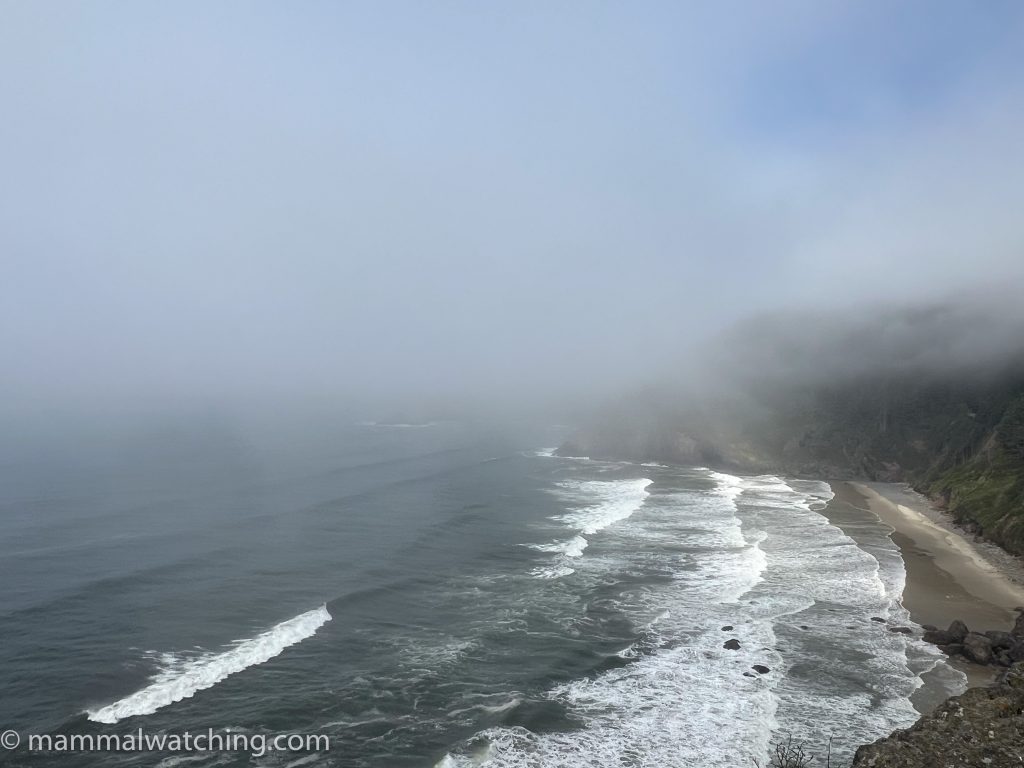
I looked for more Western Pocket Gophers to photograph along the southern Oregon coast between Heceta Head Beach and Carl G Washburne Memorial State Park (I believe the Western Pocket Gophers replace Botta’s along the coast here). There were lots of fresh diggings around the picnic table next to the overflow parking lot at the Heceta Lighthouse. I waited an hour but did not see a gopher. The only mammals were California Sea Lions from the well sign-posted viewpoint to Sea Lion Caves.
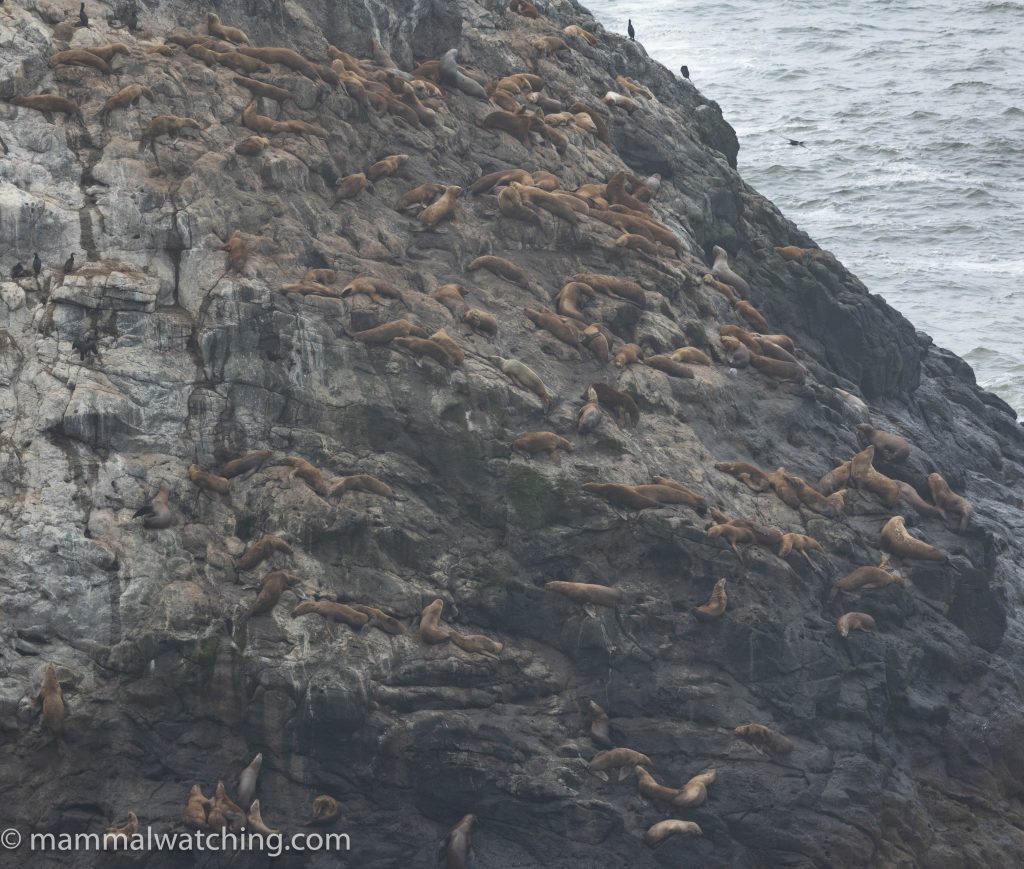
California Sea Lion (Zalophus californianus)
Salem, Oregon
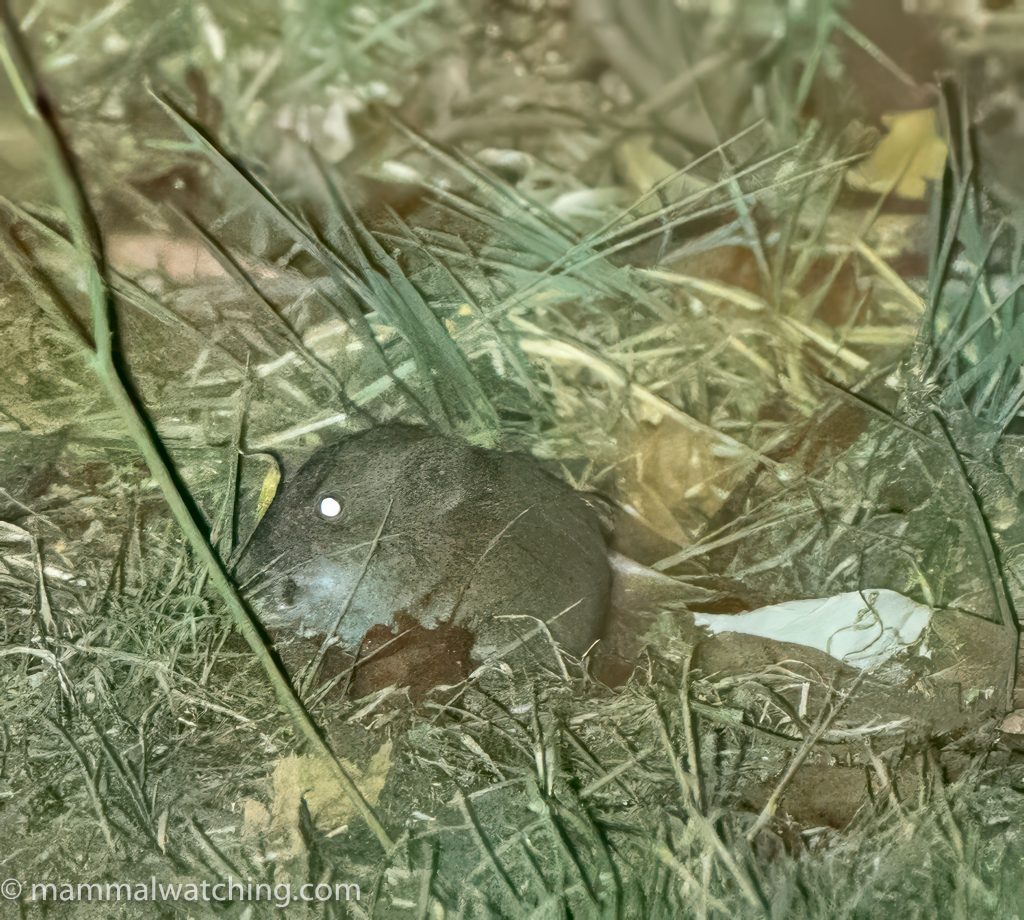
Gray-tailed Vole (Microtus canicaudus)
I spent a night at Salem in the Williamette Valley south of Portland, an area famous for its wine and its endemic rodents. I saw Camas Pocket Gophers in 2020, so I went in search of Grey-tailed Voles, the local flavour of Meadow Vole. Not the USA’s most interesting mammal species. Possibly its most boring. But a lifer is a lifer. The voles ought to be common around Salem, but after checking a few iNaturalist records and not finding any fresh diggings I returned to the Oak Grove Rest Area (northbound) on I5, where I had seen signs of what appeared to be a vole colony in 2020. There were still plenty of holes. I wandered around with a thermal scope after dark – binoculars, a flashlight and a camera behind a toilet block is always a good look – and after getting excited by several Western Deer Mice I saw my lifer vole. My flash didn’t fire so my picture does not do this spectacular and charismatic species justice. Lifer number 4.
Vantage, Washington
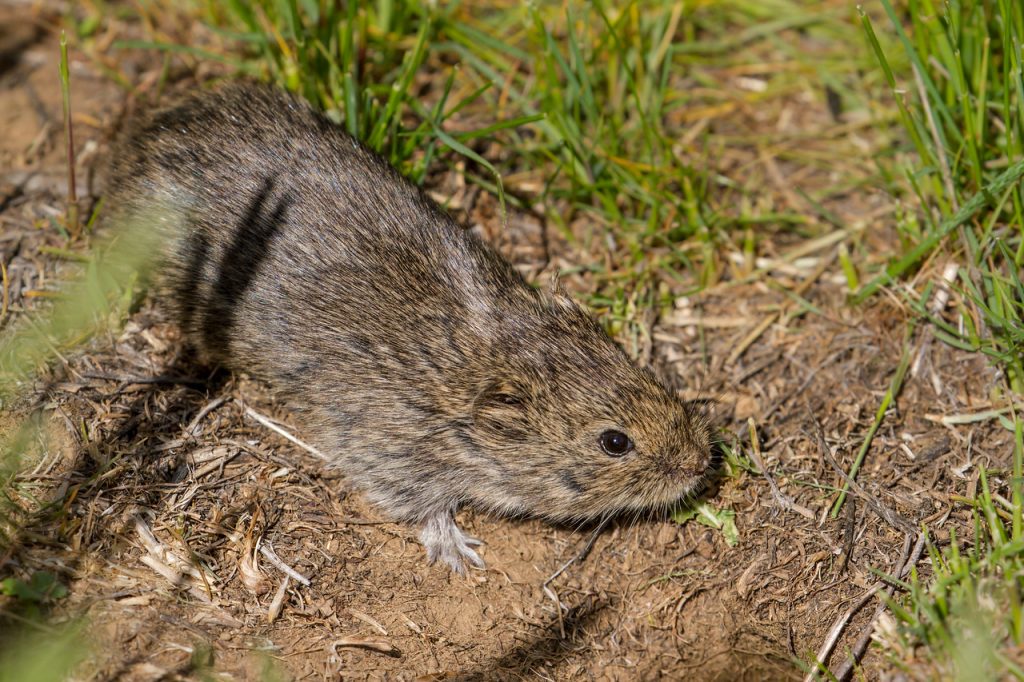
Sagebrush Vole (Lemmiscus curtatus), Photo Dasha Gudalewicz, Ryegrass Rest Stop.
I was much more excited by my next target: Sagebrush Vole. This tiny vole is the sole member of the lemmiscus genus and looks like it ought to be running around Mongolia rather than the western USA. I’d been in their habitat a few times but never seriously looked for them.
A recent iNaturalist record showed them near Vantage Washington and I contacted the author, Dasha Gudalewicz, for more information. She was extremely helpful, giving me all the information I needed and more to find the voles explaining that she “nearly always” sees them right behind the restrooms at the Ryegrass Eastbound Rest Area on I-90. Why rodents enjoy hanging out behind restrooms is as much of a mystery as why no one has called the cops yet when they have seen me searching for them.
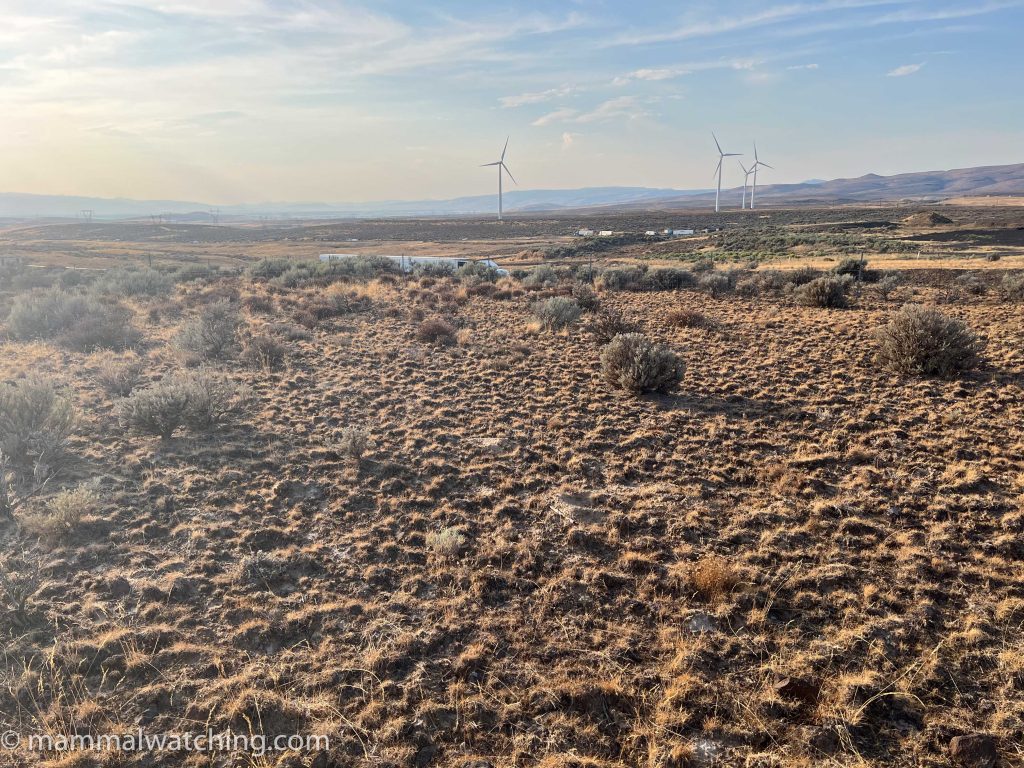
Sagebrush Voles – just behind the restrooms – habitat
Dasha had last visited in June – in the late morning – and recommended I find a hole that looked active and wait. She warned it might take an hour of more for a vole to show itself
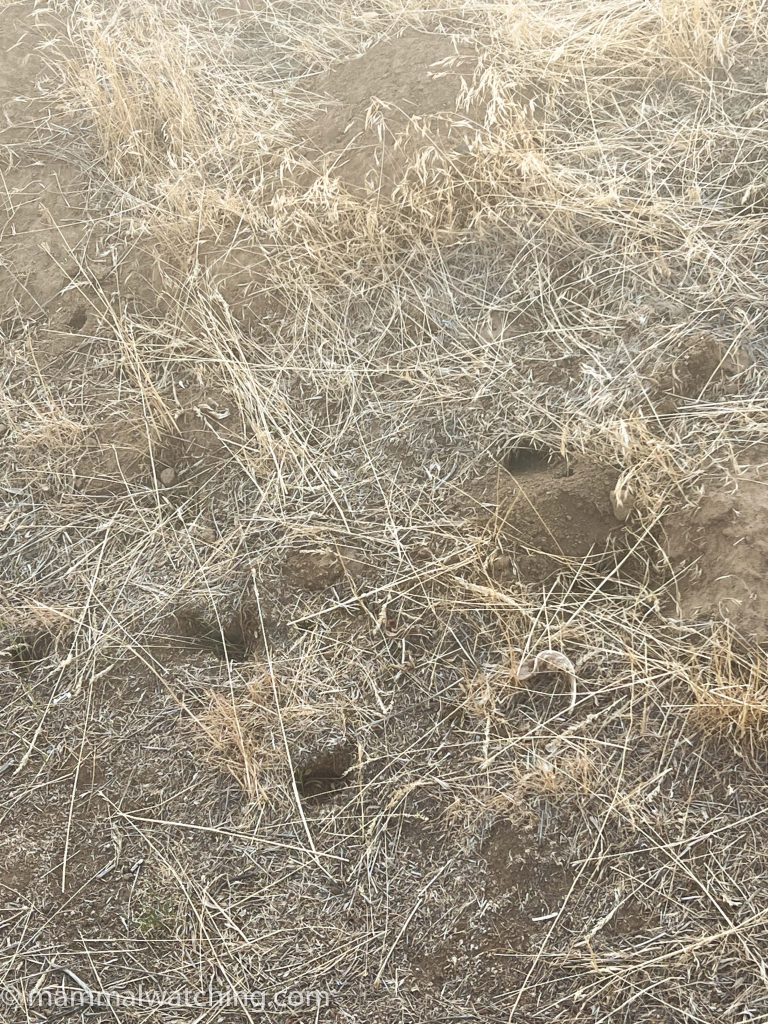
Sagebrush Vole colony
There were fresh holes everywhere and my first challenge was which to choose. I arrived a little before sunset and twice saw a flash of something volesque but I did not get a proper look.
After dark many small rodents appeared in the thermal, but those I saw well proved to be Western Deer Mice.
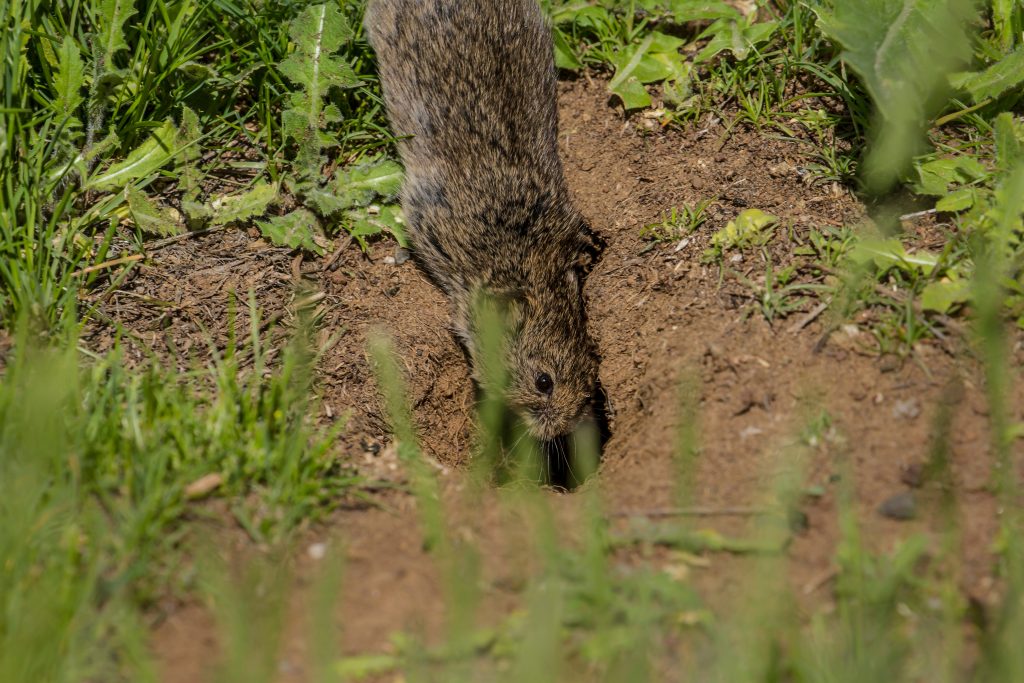
Sagebrush Vole (Lemmiscus curtatus), Photo Dasha Gudalewicz, Ryegrass Rest Stop.
I returned just before dawn the next morning. Once the deer mice had disappeared – at first light – I saw several Sagebrush Voles dashing across the trail and into holes, their size and stubby tails are distinctive. As is there speed. The photos Dasha took started to look a lot more impressive!
I got a decent look through my binoculars at one that froze under Sagebrush, though I preferred to look than take photos. I spent a further 90 minutes staking out several holes in the hope of a photo but there was no more activity. Perhaps I was unlucky or perhaps they are less diurnal at this time of year (recalling that Dasha has last visited in June and seen them in the middle of the day). Lifer number five.
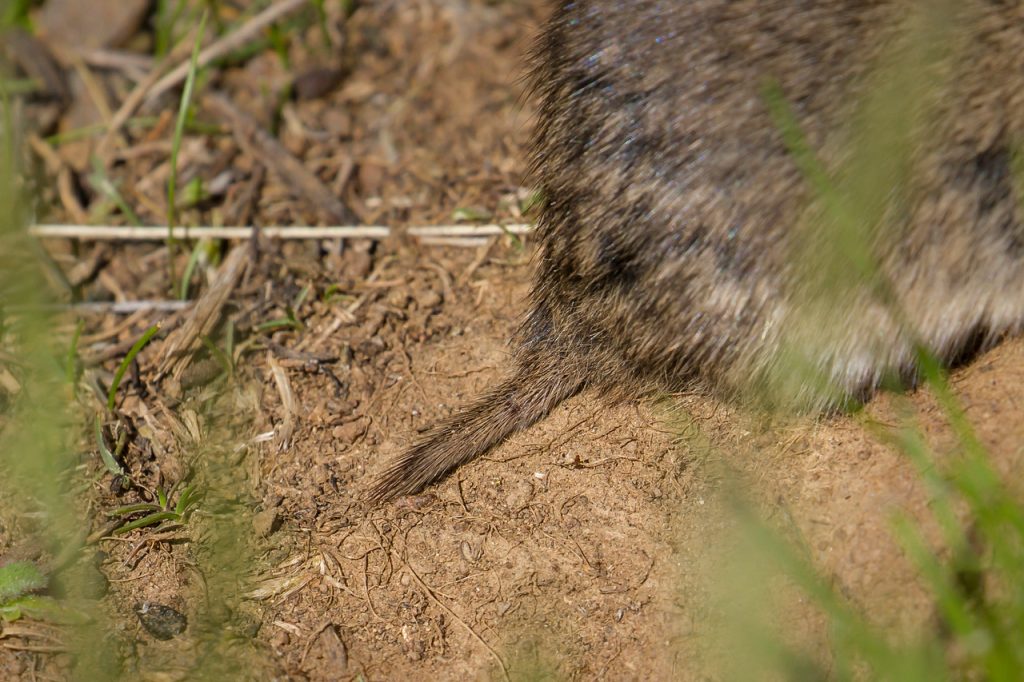
Sagebrush Vole (Lemmiscus curtatus), Photo Dasha Gudalewicz, Ryegrass Rest Stop.
There were also many Least Chipmunks scampering around.
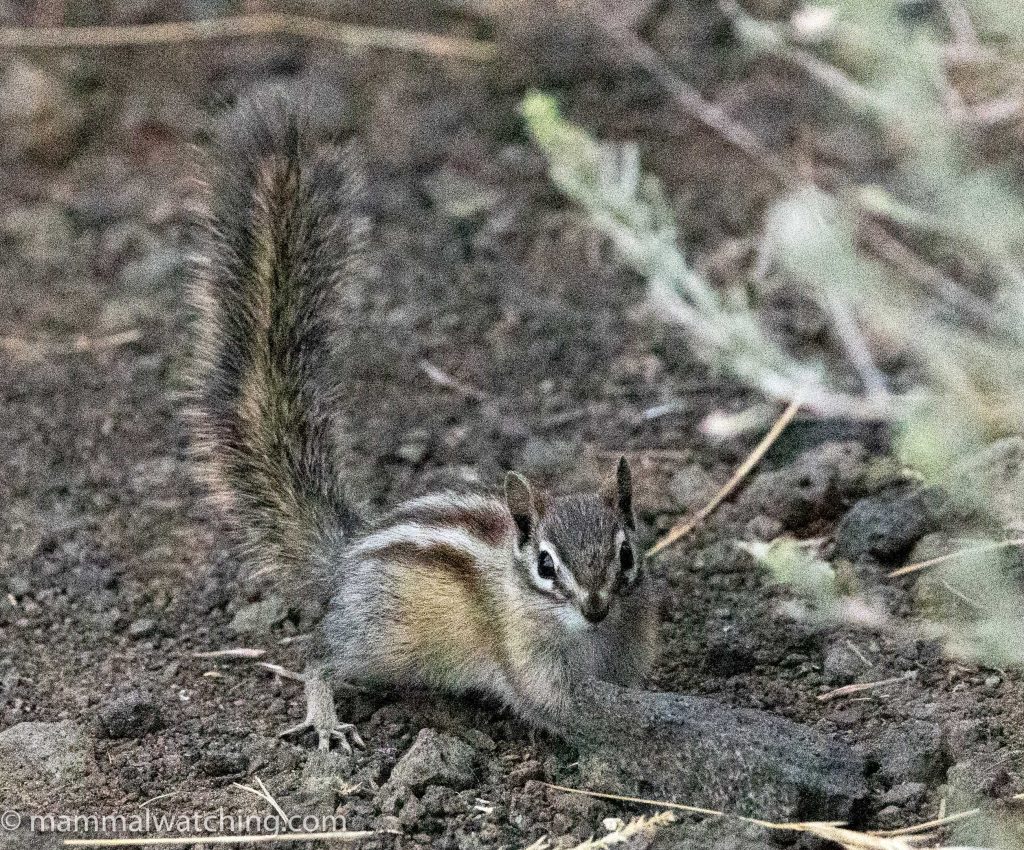
Least Chipmunk (Neotamias minimus)
Quincy, Washington
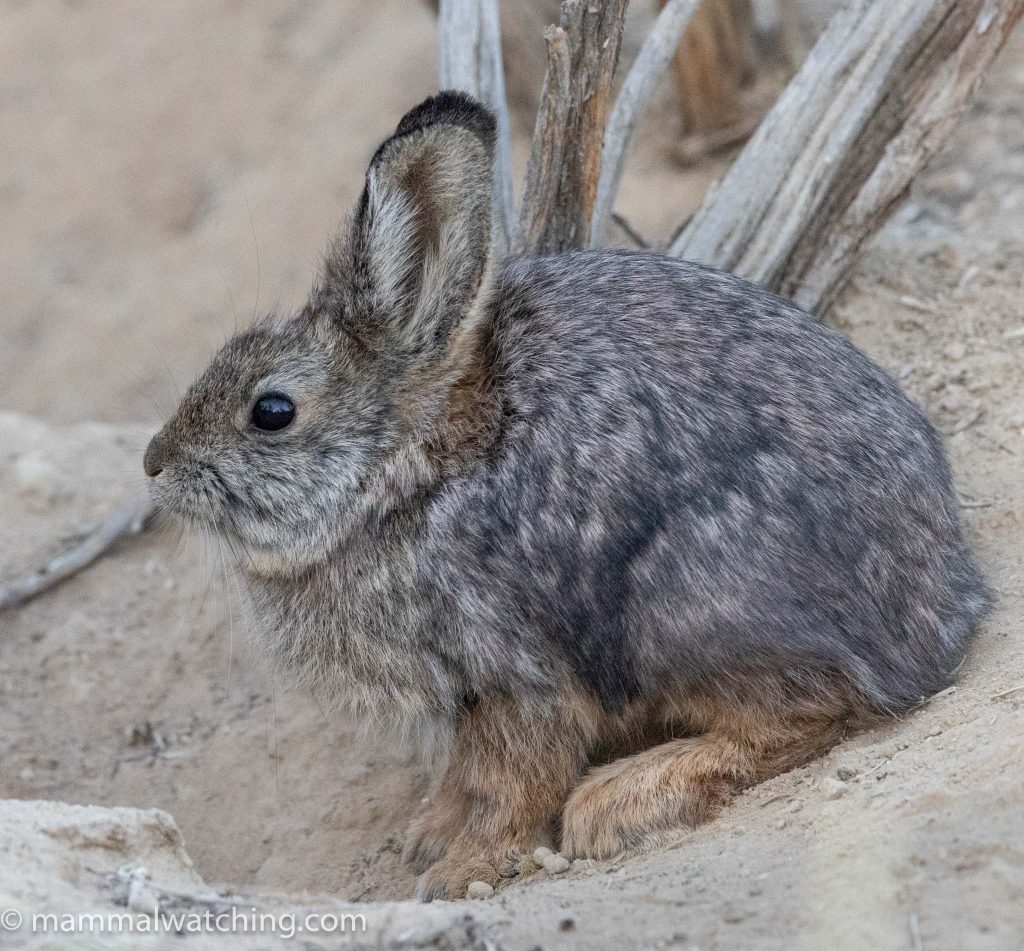
Pygmy Rabbit (Sylvilagus idahoensis). Captive breeding colony, Beezley Hills.
I spent my last night in Quincy, Washington in the heart of the “Scablands”. Someone was having a bad day when they came up with that name.
I had planned to come here in search of a second new chipmunk – the Coulee Chipmunk, split from Least Chipmunk. Tthe team who described it warned me it was harder to find than the Crater Chipmunk but I might try looking around the Beezley Hills Preserve where they were occasionally seen.
Coincidentally, after failing to photograph a Pygmy Rabbit in Nevada and wondering where else I might search, I discovered that The Nature Conservancy’s Beezley Hlls Preserve was an important part of Washington State’s Pygmy Rabbit reintroduction work. So Matt Miller – who is head of science communication for The Nature Conservancy when he isn’t showing mammalwatchers around – asked his colleagues for advice on where exactly I should look. I have lost track of how many mammals I owe Matt Miller but I suspect they are enough to keep him in free beer for the next two years if he wanted to cash in his credits.
Although the rabbits’ presence in the preserve is public knowledge, the reintroduction team are cautious about broadcasting details. The state has been working to reintroduce the species since 2007 but there are still only 100 – 150 rabbits in Washington. It is little wonder the work is so challenging when the rabbits run the gauntlet of fire, disease and climate change. The team agreed to give me some quite detailed instructions on where I should look, so long as I washed my car and boots (or anything else that had been in Nevada where Rabbit Hemorrhagic Disease Virus is present) and promised not to cross fences etc.
Three hours wandering along roads – and in the sagebrush – at dusk did not produce any Pygmy Rabbits though I was momentarily excited by an Eastern Cottontail (surely destined to be split).
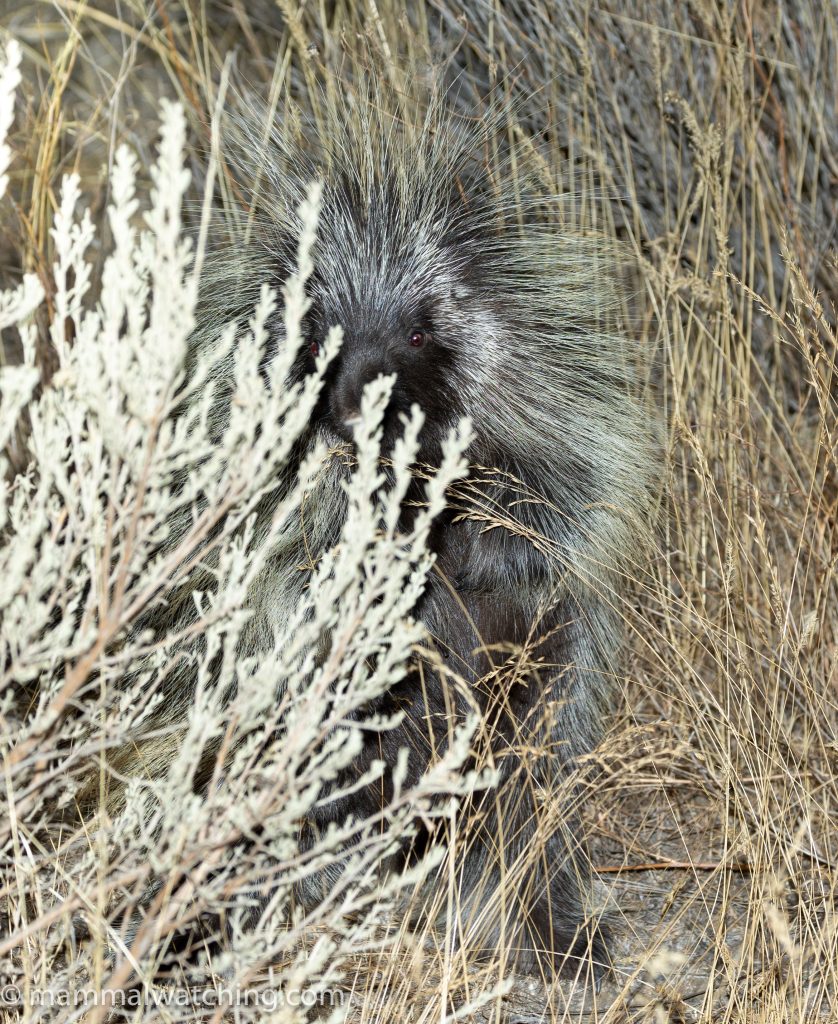
North American Porcupine (Erethizon dorsatum)
I returned at 10pm and my thermal scope found a wild Pygmy Rabbit hunkered down under Sagebrush. I got a good look but did not take any pictures. I also saw a gorgeous Porcupine crossing the road as I drove back to Quincy. I’d forgotten what an under-rated mammal this is.
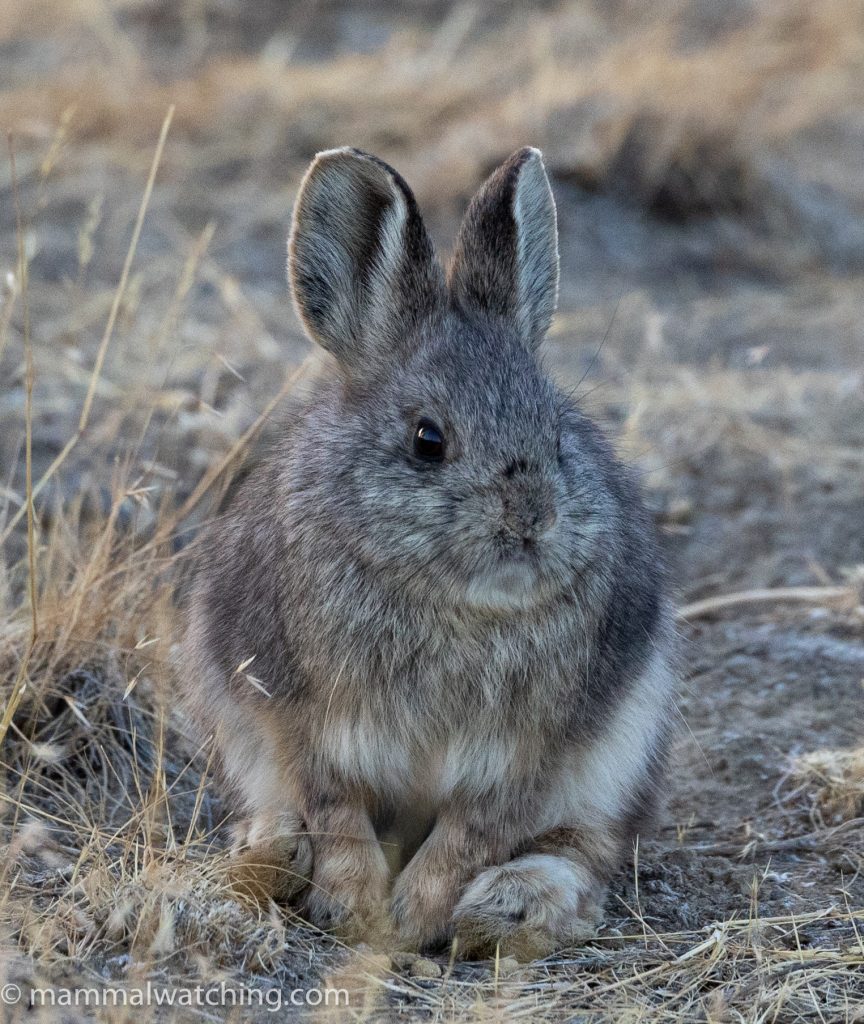
Pygmy Rabbit (Sylvilagus idahoensis). Captive breeding colony, Beezley Hills.
I didn’t have to leave for Spokane Airport until 8 the following morning and so rabbit researcher Miranda Crowell invited me to join her at dawn for a tour of the Pygmy Rabbit breeding enclosure. Great to get a chance to talk rabbits with her and get long looks at this delightful species. Miranda also confirmed that she has seen chipmunks in the enclosure – Coulee Chipmunks presumably – but they did not sound common. She thought she had seen two or three this year.
Thank you
Thank you Venkat Sankar for the advice pre – and during – the tour and also to Dasha Gudalewicz and Lex Orr for their help with my vole searching. I’m grateful to Nathanel Herrera, Jeffrey Good, Kayce Bell and John Demboski, co-authors ot the paper describing the Crater and Coulee Chipmunks for their help with my chipmunk hunt. Thanks to to Miranda Crowell and Jon Gallie from the Washington Department of Fish and Wildlife Pygmy Rabbit reintroduction team, and to David Morgan from The Nature Conservancy for introducing me to them. And a big thanks to Matt, Jennifer and Derek Miller for another very fun, double lifer, Idaho weekend!
I was happy with my five lifers, and happier that I still have lots of reasons to return to this beautiful part of the world. Bring on those Pacific Martens, tree and creeping voles!
Trip List
Black-tailed Jackrabbit (Lepus californicus)
Eastern Cottontail (Sylvilagus floridanus)
Pygmy Rabbit (S.idahoensis) – endemic
Mountain Cottontail (S.nuttallii)
North American Porcupine (Erethizon dorsatum)
North American Red Squirrel (Tamiasciurus hudsonicus)
Common Golden-mantled Ground Squirrel (Callospermophilus lateralis)
Crater Chipmunk (Neotamias cratericus) – Lifer
Least Chipmunk (N.minimus)
Yellow-cheeked Chipmunk (N.ochrogenys)
Sonoma Chipmunk (N.sonomae) (?)
Botta’s Pocket Gopher (Thomomys bottae) – signs only
Western Pocket Gopher (T.mazama) – Lifer
Townsend’s Pocket Gopher (T.townsendii) – Lifer
Ord’s Kangaroo Rat (Dipodomys ordii)
Great Basin Pocket Mouse (Perognathus mollipilosus)
Sagebrush Vole (Lemmiscus curtatus) – Lifer
Gray-tailed Vole (Microtus canicaudus) – Lifer
Montane Vole (M.montanus)
Western Deermouse (Peromyscus sonoriensis)
Long-eared Myotis (Myotis evotis) (?)
California Sea Lion (Zalophus californianus)
Puma (Puma concolor) – signs only
Pronghorn (Antilocapra americana)
Mule Deer (Odocoileus hemionus)
Wapiti (Cervus canadensis)
Post author


Leave a Reply
You must be logged in to post a comment.